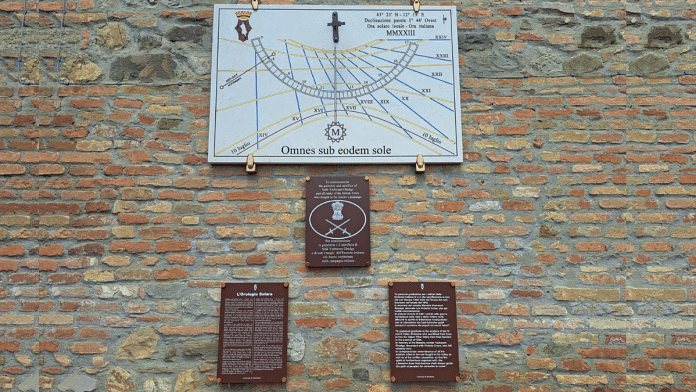New Delhi: A memorial to commemorate the 50,000 Indian Army soldiers who fought for the liberation of Italy from Nazi occupation during the Italian Campaign in World War II was unveiled in Italy Saturday. The ‘V.C. Yeshwant Ghadge Sundial Memorial’ was unveiled by the Commune of Monotone (in Italy) and Italian military historians at Montone in Perugia as a tribute to Indian troops who died in action during the Italian Campaign.
The soldiers were part of the 4th, 8th and 10th Divisions of the British Commonwealth forces that fought against the Axis powers — Germany, Italy and Japan. The Italian Campaign refers to the two-year campaign (1943-1945) by the Allied power — Great Britain, the US and the Soviet Union — to liberate Italy from German occupation.
Among the Indian soldiers who were honoured was Naik Yeshwant Ghadge. The memorial in his honour is a sundial that symbolises unity. Inscribed on it is the motto “Omines Sub Eodem Sole”, which translates to “we all live under the same sun”.
Dr Neena Malhotra, India’s Ambassador to Italy and the Indian Defence Attaché represented India at the ceremony. Many Italian citizens, distinguished guests and members of Italian armed forces also attended the event Saturday.
Inauguration of Yeshwant Ghadge sundial memorial will deepen the unique historical connect between 🇮🇳 and 🇮🇹. A special post card was also released. Distinguished guests from Italian government, military, military historians and citizens graced the occasion. @MEAIndia @adgpi pic.twitter.com/ik4QRbON3k
— India in Italy (@IndiainItaly) July 22, 2023
Interestingly, of the 20 Victoria Crosses awarded in Italy, six were given to Indian soldiers.
Indian soldiers suffered 23,722 casualties, of which 5,782 lost their lives and are commemorated in the 40 Commonwealth War Graves spread across Italy.
Also Read: Modi’s visit to Heliopolis shows India is no longer ashamed of its British Army soldiers
Naik Yeshwant Ghadge
The memorial unveiled Saturday was named after Naik Yeshwant Ghadge, Victoria Cross, who was killed in action fighting on the heights of Upper Tiber Valley on 10 July 1944, as a mark of honour.
Naik Ghadge was a soldier of the Mahratta Light Infantry who served in Italy during World War II (1939-1945). According to the National Army Museum of the UK, he was only 22 when he died in action while fighting the Axis powers.
He received the Victoria Cross posthumously in 1944.
Following the breach of the German positions around Lake Trasimeno in mid-1944, the Allies advanced northwards towards the next major line of German defences, known as the Gothic Line.
In the first stage of this operation, the 3/5th Mahratta Light Infantry, with other units of the 10th Indian Division, was to advance from Perugia through the mountainous terrain of the upper Tiber Valley to assist with the capture of the town Citta de Castello.
The Mahrattas reached Pianello on 30 June. But from there, they faced a series of mountains including Monte Cucco, Monte Gengarella and Monte Marucchino before reaching Monte Delle Gorgacce.
By July 8, they fought their way up to Mount Gengarella. Point 613, near Monte Gengarella, came under pressure from German counter-attacks mounted from Point 624. This was strongly defended by enemy machine guns.
On 10 July 1944, while fighting in the Upper Tiber Valley, the ‘C’ Company that was dispatched to launch a strike against Point 624 came under heavy machine-gun fire, which killed everyone in the section except Naik Ghadge. The Company also lost its commander, Captain Madiman, and six others and had 15 more men wounded.
Naik Ghadge was the only survivor in his section.
His citation describes how he then charged at the machine gun post and threw a grenade that destroyed the machine gun and its operator. He then used his Tommygun to shoot another member of the gun crew. He had no time to reload his gun, so he used it as a club to kill the remaining two men of the gun crew.
Hit by sniper bullets in the chest and back, Naik Ghadge at the post he had captured single-handedly for the Allies. As a result of his bravery, the Germans had to retreat from point 624, allowing the Mahrattas to move forward.
(Edited by Richa Mishra)






